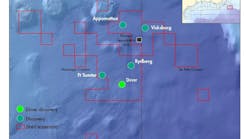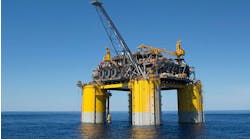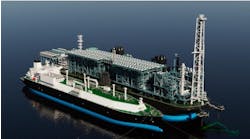Deepwater risers key element in adaptation
Henning Christensen, Svein Are LoetveitThe Voering Plateau off Mid-Norway extends to 1,400 meters water depth. Current deepwater field development scenarios and riser concepts are not necessarily applicable to Voering. However, the experience gained from existing riser concepts could be of considerable value.
Seaflex
For Voering, the possible riser system solutions at present are:
- Hybrid riser towers (semisubmersible, ship)
- Rigid steel riser (TLP, Spar)
- Rigid composite riser (TLP, Spar)
- Metallic catenary riser (TLP, semi, ship)
- Metallic long wave riser (TLP, semisubmersible, ship)
- Flexible riser (TLP, semisubmersible, ship).
But how can the experience from existing flexible and steel catenary deepwater riser concepts be applied, and what added work is required to meet Voering's needs?
Most of the challenges met offshore Brazil and in the US Gulf of Mexico also apply to Voering. Issues related to deepwater such as collapse, axial loads, hydrate control, thermal insulation and top tension have, more or less, universal applicability.
What is special with the Voering area is the wind and wave conditions. In addition, the seabed soil conditions are very soft. Whether the reservoir conditions will also be special remains to be seen.
The severe wave and wind conditions impose much greater dynamic loading on the riser system, from the waves directly, but mainly from the floater. The combination of first and second order motions imposes loads on the risers which are not experienced in existing deepwater riser installations. Areas of concern are
- Increased riser tension
- Increased motion envelope
- Severe vortex-induced vibrations (VIV)
- Increased motion in the touchdown area.
- High vertical and horizontal loads on the floater
- Fatigue due to 1st and 2nd order effects
- Fatigue due to VIV
- Buckling behavior in touchdown area
- Riser interference due to VIV and sheared current.
For flexible risers, the loads imposed on the floater will be more vertical, but most likely higher than with metallic risers. The structural use of flexible risers on Voering will be greater than that experienced previously. The combination of high tension and greater dynamic motions implies that the experience from the Campos Basin is not fully applicable. Fatigue is of most concern. Operators as well as manufacturers have limited knowledge of the fatigue performance of flexible risers exposed to Voering conditions.
Voering's soft soil poses a special problem for risers with a moving touchdown area (catenary and wave risers), a problem not experienced in present installations. Only on-site testing of relevant riser configurations can provide the necessary information to understand how the soft soil will influence the riser behavior.
Riser research
The ongoing work on metallic and flexible risers for floating production units is largely expected to close the gap between existing riser installations and the Voering requirements.Based on ongoing flexible riser development work combined with the experience gained offshore Brazil, flexible risers are regarded as technically feasible for Voering. What is important is to acquire more knowledge of the failure mechanism and fatigue performance of flexible risers for the kind of loads that can be expected on Voering. At 1,000 meter water depths and beyond, it is vital that the risers have adequate and predictable service life. Riser replacement in ultra-deep water will be costly.
The reason for pursuing metallic catenary or long wave risers is to ensure feasible alternatives to flexibles. The risers may be all steel or may include sections with more sophisticated materials such as titanium. Experience gained in the Gulf of Mexico and soon to be gained in the Campos Basin indicates that metallic risers are feasible for Voering. However, the threshold to take this technology into use on Voering is higher than for flexibles. A full-scale steel riser test has been proposed by Statoil.
Initially, a full-scale deepwater mooring test without a riser is planned at Voeringplataet at 1,300-meter water depths, with a duration of 10 months. Aker Marine Contractors has the contract for planning and performance of the test. This comprises a barge anchored with three fiber mooring lines and suction anchors.
Critical parts of the anchors and mooring lines will be instrumented to enable continuous monitoring. The plan is then to extend the mooring test by 10-12 months and include a full scale riser test.
The main advantage of using the mooring barge for the riser test is that the barge is in place and is dedicated to test purposes. This reduces investment costs considerably. Alternately, the riser could be connected to an existing drilling or production platform.
The full-scale riser test on Voering is estimated to cost around NKr 45 million, including installation and decommissioning. Objectives are to investigate installation and operation of a steel riser in deep water, harsh environmental conditions and special soil conditions, and also to calibrate riser design tools. Specific items to be investigated include:
- Global behavior of the riser
- Riser pipe stresses
- Seabed interaction
- Vortex shedding
- Top termination arrangement
- Integrated behavior or the riser/mooring system/barge
- Handling and installation.
System definition
The proposed test riser is a 6-in. steel version suspended in a long wave configuration, although a simple steel catenary riser may be considered as an alternative for cost-cutting purposes. Although it must be expected that this riser will be damaged during the test, the damage may not impair the test.The most likely failure is controlled plastic deformation of the touchdown area. Riser diameter choice is a compromise between the total test cost and desired properties relating to installation and operation. Main characteristics of the long wave steel test riser are as follows:
- The riser top terminates with a flex-joint or flex-element
- Riser length is 3,600 meters
- Touchdown area static is 1,850 meters from balcony termination
- Riser static angle at top termination is 6° relative to barge vertical
- Riser top angle is 62°
- Buoyancy elements starting/ending are 1,600 meters per 2,500 meters from riser top
- Buoyancy elements net buoyancy is 503 N/m, with a total of total 453 kN
- A fixed anchor point on the seabed
- Maximum dynamic vertical top tension of 760 kN
- Maximum dynamic horizontal top tension of 340 kN.
A riser balcony will be pre-installed on the barge to permit simple docking of the riser top end to the barge. This balcony measures 5.70 meters by 3.20 meters and will accommodate most of the riser installation and operating equipment, and includes foundations for the installation winch and A-frame.
The balcony structure comprises two longitudinal deck beams. Over-hang is such that the center of the riser will be 1,450 mm from the barge's side. The riser's flexible termination results in moderate bending moment being imposed on the hang-off system and balcony.
The riser will be extensively instrumented to enable monitoring of global behavior and stresses. Simultaneous measurement of environmental conditions will be performed to allow re-calculation of the riser behavior and loads. The aim of the measurements is to verify and calibrate the design model and detect response features that have not been accounted for in the design model. Robit Technology in Asker, Norway performed the instrumentation study.
Data loggers, sensors and communication and power cables will be placed inside the riser. A topside computer will collect data from all measurement stations in real time and store the data on disk files. Statistical parameters will be calculated on-line and stored in separate files. The computer will be linked to a satellite communications link so that data can be accessed from onshore locations.
Controlled depth towing is the proposed installation method for the 6-in. test riser, with fabrication performed perhaps in Orkanger or Verdal, both relatively near the Voering Plateau. During tow-out, the controlled depth tow method configuration will be obtained by applying chain ballast in the permanently buoyant section. Net buoyancy of the riser is adjusted to enable control of net buoyancy by variation in tow velocity.
As the tow approaches the test site the lead tug reduces the bollard pull on the riser while the back tension is increased until the riser reaches its appointed location. With the lead tug as close to the barge as possible, the back tension is lowered until the buoyant mid-section sinks to the seabed. Only the chains are then in contact with the seabed. An ROV then connects the pull-in wire from the barge winch to the riser tow head and the riser top is gradually transferred from the lead tug tow wire to the barge winch wire. On release, the lead tug will assist in pulling in the buoyant section of the riser into the desired location.
At site, the riser top is transferred to the barge. Then the temporary buoyancy and anchor chains are removed before connecting the riser bottom end to the subsea anchor. Work on the installation has been performed by Stolt Comex Seaway in Stavanger.
Reference
"Deep Water Risers Design from Experience," Under water Technology Conference, Bergen, March 1998.Copyright 1998 Oil & Gas Journal. All Rights Reserved.


